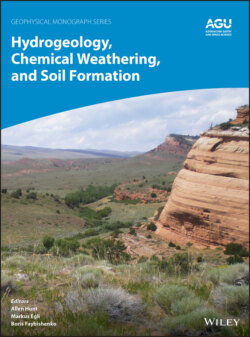Читать книгу Hydrogeology, Chemical Weathering, and Soil Formation - Allen Hunt - Страница 31
1.5.2. New Pedologies
ОглавлениеBiopedology, the oldest of the new pedologies, considers interactions between soils and life. Its origins lie with Charles Darwin and his work on earthworms (e.g. Darwin, 1881). Darwin was also the first to recognize the importance of faunal mixing in soil formation and the textural sorting it can produce (Johnson, 2002; Brevik & Hartemink, 2010). Biopedology has made a strong comeback in the last few decades with research into bioturbation and biomantle theory (e.g. Hole, 1961; Johnson, 1990; Peacock & Fant, 2002; Johnson et al., 2005a, 2005b; Saco & Moreno‐de las Heras, 2013; Gabet et al., 2014; Fleming et al., 2014; Johnson & Schaetzl, 2015); it is also benefitting from research in biogeomorphology (e.g. Verboom & Pate, 2013; Pawlika & Šamonil, 2018; see also Huggett, 2017).
The second oldest of the new pedologies is geopedology, which is short for geomorphopedology and focuses on the interdependency between soils and geomorphology. The argument is that soils and vegetation seldom develop in a totally inactive geomorphological environment: the landscapes in which soils and vegetation develop normally change. Thus, the development of terrestrial ecosystems and the geomorphological development of landscapes take place at the same time and influence one another. Pedologists were alerted to this fact by Shaw (1930), Robinson (1936), and Milne (1936), who discussed the role of erosion and deposition in soil evolution (see above). Indeed, soil geomorphology began in the USA in the 1930s with a spate of soil erosion studies made under the auspices of the USDA (Effland & Effland, 1992). In 1952, the USDA set up a Soil‐Geomorphology Group that included Robert V. Ruhe, who championed the process dimension of Milne’s catena concept (e.g. Ruhe, 1960), arguing that it is the clearest general systems statement about soil geomorphology, integrating the factors in explaining soil differences while focusing on past history of the land surface, geohydrology, erosion, sediment transport, and pedogenic processes (Ruhe, 1975; Birkeland, 1990; Johnson & Hole, 1994). Geopedology has blossomed over the last couple of decades (see Zinck et al., 2016) and the advent of sophisticated soilscape–landscape deterministic models has given it a new impetus (e.g. Willgoose, 2018).
Hydropedology is one of the latest pedologies. It is “an emerging intertwined branch of soil science and hydrology that studies interactive pedologic and hydrologic processes and properties in the Earth’s Critical Zone [and that] aims to bridge disciplines, scales, and data, connect soils with the landscape, link fast and slow processes, and integrate mapping with monitoring and modeling to provide a holistic understanding of the interactions between the pedosphere and the hydrosphere” (Ma et al., 2017). Unlike conventional soil science, it emphasizes in situ soils in the landscape, which have distinct pedogenic features and varying environmental settings (Lin et al., 2012). In doing so, it yields a more realistic and integrated understanding of real‐world soil and hydrological processes.
Anthropopedology is the study of the human impact on soils. It has a long history. Dan Yaalon and Bruno Yaron (1966) used the term metapedogenesis to cover human‐made soil changes; Ron Amundson and Jenny (1991) considered the place of the human species in the state‐factor theory of ecosystems. But two‐way interactions between soils and the human sphere (anthroposphere) have been the subject of increased research over the last few decades owing to the recognition of soil as an indispensable resource (e.g. Richter & Yaalon, 2011). Topics investigated include coupled human–natural landscapes (Barton et al., 2016) and the evolution of technosols (soils subjected to a strong human influence and containing significant amounts of artefacts, characteristic of the Anthropocene; Leguédois et al., 2016). Research in anthropopedology becomes ever‐more pressing as human security comes to rely increasingly on Earth’s diverse soil resources. As Amundson et al. (2015) point out:
Soil is the living epidermis of the planet. Globally, soil is the medium through which a number of atmospheric gases are biologically cycled and through which waters are filtered and stored as they pass through the global hydrological cycle. Soil is a large and dynamic reservoir of carbon and the physical substrate for most of our food production. Profound changes are on the horizon for these interconnected functions—particularly sparked by changes to climate and food production—that will likely reverberate through society this century.
